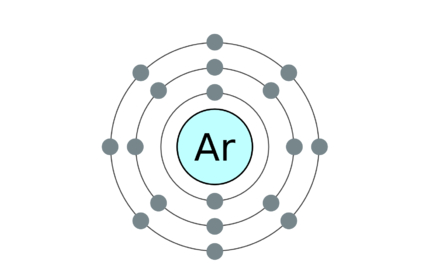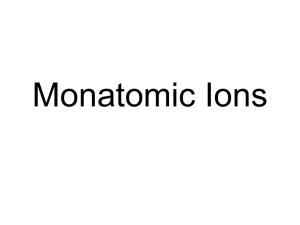- Symbols and Charges for Monoatomic Ions Symbol Name Symbol Name H+ hydrogen ion H¯ hydride Li+ lithium ion F¯ fluoride Note that the Na+ sodium ion Cl¯ chloride letters in an ion’s K+ potassium ion Br¯ bromide name before the Rb+ rubidium ion I¯ iodide -ide ending is Cs+ cesium ion O2¯ oxide the stem.For Be2+ beryllium ion S2¯ sulfide example, the stem.
- Start studying Monatomic Ion List. Learn vocabulary, terms, and more with flashcards, games, and other study tools.
Writing Electron Configurations for Monatomic Ions
Zn 2+ zinc ion Al 3+ aluminum ion. Note that the letters in an ion's name before the - ide ending is the stem. For example, the stem for bromide is brom. Also, just in case, the P for. Phosphide is a capital P. Symbols and Charges for Monoatomic Ions. Variable Charge. Golden Sheet of Nomenclature Symbols and Charges for Monoatomic Ions Symbol Name Symbol Name Symbol Name H + hydrogen ion Sr 2+ strontium ion Br -bromide Li + lithium ion Ba 2+ barium ion I -iodide Na+ sodium ion Ra 2+ radium ion O 2-oxide K + potassium ion Zn 2+ zinc ion S 2-sulfide Rb+ rubidium ion Ca 2+ calcium ion Se 2-selenide Cs+ cesium ion Al 3+ aluminum ion Te 2-telluride. An atom of rubidium (Rb) forms a monatomic ion. Which of the following ions does it most likely form? Rb2+ Rb Rb+ Rb2 2. On the basis of electronegativity, which of these pairs of elements is most likely to form monatomic ions? Cs and Cl Ba and O O and P Na and Br 3. Which of the following pairs of elements would most likely form a salt? Na and Al K and I I and F O and F 4. On the basis of.
We know that many atoms gain or lose electrons to achieve the same number of electrons as the nearest noble gas. We can now make a more general statement about the formation of monatomic ions.
Certain monatomic ions form when atoms gain or lose electrons to achieve a stable electron configuration for their highest energy electrons.
The inactivity of the noble gases tells us that there is something especially stable about the 1s2 configuration of helium and the ns2np6 configuration for the highest energy electrons of the other noble gases (2s22p6 for neon, 3s23p6 for argon, and so on). Therefore, we should not be surprised that when many monatomic ions form, they gain or lose electrons to achieve a 1s2 or ns2np6 configuration. For example, lithium forms Li+, with the 1s2 configuration, magnesium forms Mg2+, with the 2s22p6 configuration for its highest energy electrons, and chlorine forms Cl-, with the 3s23p6 configuration.
LiLi++e-
1s2 2s11s2
MgMg2++2e-
Cl+e-Cl-
1s2 2s2 2p6 3s2 3p5 1s2 2s2 2p6 3s2 3p6
Metallic atoms lose one, two, or, at most, three electrons in order to form ions. (You will sometimes see ions described as if they had lost four electrons to form +4 ions. For example, you might see a statement that says that tin forms +2 and +4 ions. In fact, too much energy is required to completely remove a fourth electron from an atom; when an atom has a +4 oxidation state, its bonds are better described as covalent bonds instead of ionic bonds. The electrons are shared between atoms, not transferred from one atom to another.) Therefore, the metallic elements in groups 4 through 15 have too many electrons to be able to reach a noble gas electron configuration by losing electrons. Some of these metallic elements instead form ions that lead to relatively stable nd10 electron configurations. For example, zinc atoms form Zn2+ ions with the 3d10 electron configuration.
Monatomic Ion Examples
ZnZn2++2e-
[Ar] 3d10 4s2[Ar] 3d10

When we write the electron configuration or orbital diagram for zinc, we know to fill the 4s sublevel before adding electrons to the 3d sublevel. Therefore, we might expect that the two electrons lost in ion formation come from the 3d orbitals instead of the 4s. This is not the case. One way to understand why is to consider the attraction between the electron being removed and nuclear charge of the atom it is leaving. The electrons that are easiest to remove are the electrons that are least attracted to the nucleus. The larger the orbital is, the greater the average distance between it and the nucleus. This leads to less attraction between the nucleus and the electron and makes the electron easier to remove. Because the 4s orbital is larger than the 3d orbitals, the attraction between it and the nucleus is weaker.
When cations form, electrons are lost from the largest orbitals first.
Red button. This is the reason why it is a good habit to write abbreviated electron configurations with the orbitals listed in the order of increasing principal energy level and not in the order of filling of the orbitals. The higher the principal energy level is, the larger the orbitals in that level are. Thus, listing the orbitals in the order of increasing principal energy level will put the electrons for the largest orbitals on the right-hand end of your electron configuration, reminding you that they are lost first.For example, if you were to write zincs electron configuration in the order of filling of the sublevels, you might forget that the 4s electrons are lost when Zn2+ forms.
Zn [Ar] 4s2 3d10(in the order of sublevel filling)
Episodes matt leblanc ringtone download. Zn [Ar] 3d10 4s2(in the order of increasing principal energy level)
Some metallic elements form ions that lead to relatively stable electron configurations with the nd10(n + 1)s2 configuration. For example, tin atoms form Sn2+ ions with the 4d105s2 electron configuration.
Marquette mac 5000 service manual. SnSn2++2e-
[Kr] 4d10 5s2 5p2[Kr] 4d10 5s2
Monatomic Ions Quizlet

The elements Ga, In, and Tl can form ions that have either +1 charges, with an nd10(n+1)s2 configuration, or +3 charges, with an nd10 configuration. For example, thallium atoms form Tl+ and Tl3+ ions.

TlTl++e-
[Xe] 4f14 5d10 6s26p1[Xe] 4f14 5d10 6s2
TlTl3++3e-
[Xe] 4f14 5d10 6s26p1[Xe] 4f14 5d10
In sum, we can make the following general statement about the formation of monatomic ions.
Ions tend to form in order to gain the 1s2, ns2np6, nd10, or nd10(n+1)s2 electron configuration for their highest energy electrons.

Thus, Li+ has the 1s2 configuration; Cl- has the ns2np6 configuration of [Ne] 3s23p6; Zn2+ has the nd10 configuration of [Ne] 3d10; and Sn2+ has the nd10(n+1)s2 configuration of [Kr] 4d10 5s2.
Monatomic Ions List
This general guideline helps us to predict the ionic charges for many of the elements on the periodic table.On the other hand, it has some limitations. For example, we have seen that the statement is only true if the atoms can reach one of the stable configurations by gaining or losing one, two, or three electrons. The atoms of the elements in groups 4-10 (4B-8B) are too far away to reach one of these stable configurations, so they form less easily predicted charges. These charges have been determined experimentally.Chemists either memorize them or find them in a reference work. For example, we know that iron atoms form either +2 or +3 cations. Although we can predict the electron configurations for iron ions that have these charges, we would not have been able to predict that these charges would form based on the position of iron on the periodic table. The way we remember the charges on iron ions is to memorize them.
Fe Fe2++2e-
[Ar] 3d6 4s2[Ar] 3d6
FeFe3++3e-
[Ar] 3d6 4s2 [Ar] 3d5
The figure below shows ions with predictable Charges. Some of these elements also form other, less easily predicted charges.
Click here to see a sample study sheet for predicting ionic charges and writing abbreviated electron configurations for ions.
Click here to see an example.
Click here to see an exercise.
